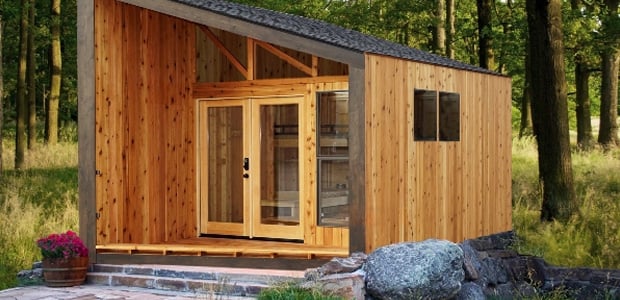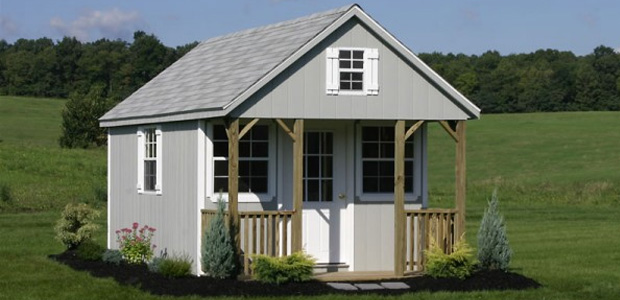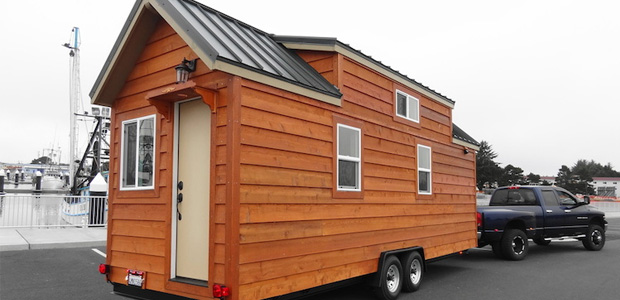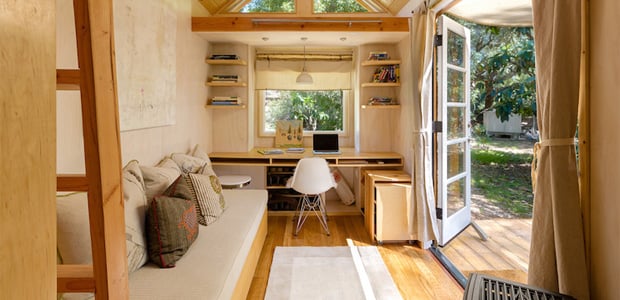
The average American house has doubled in size from a generation ago, but a recent worldwide micro-trend is moving in the other direction — toward serious shrinkage.
These new diminutive domiciles appeal to empty nesters as well as those looking to cut back on their carbon footprints and save money. The trendiest tiny houses, some serving as camping cabins or rental houseboats, are quickly moving into the residential market. They boast a whopping 65-400 square footage.
Walk-in closet, right? But what they lack in size, they make up for in so many other ways.
So What Exactly Are Tiny Houses?
Tiny houses are so much more than small homes. They reflect an approach to living that, for some, is a welcome departure from the typical oversized American house. Instead of excess, tiny houses embrace compact space and simplified living. They may be small in stature, but tiny houses have grown to include a nationwide movement of homeowners who want to adopt a lifestyle that’s environmentally conscious, financially responsible and self-sufficient.
While Tiny Houses aren’t for everyone, there are a few main reasons they appeal to the folks that join the downsizing movement.
#1 They’re Adorable
Architects around the world are adding their own personal touch to tiny houses, making these small abodes a great place to show off your sense of design. Tiny houses range in style from miniature log cabins to compressed Victorian homes to contemporary tree houses to nautical-inspired spaces complete with portholes. Since you can build tiny houses with a variety of materials and designs, the possibilities are nearly endless.
Ready to start your tiny home?
Find Pros
#2 They’re Mobile
Many tiny houses are mobile and easy to relocate when the mood strikes. Some even come with wheels attached, so you can take your tiny house with you, just like you would an RV. Rest assured that most mobile tiny houses don’t look like RVs, though. Instead, they typically look just like small houses, complete with a living room, bedroom and porch.

#3 They’re DIY-able
Handy homeowners can order many tiny houses online. The houses typically arrive as easy-to-assemble kits that include precut pieces or panels, along with flooring, shingles, hardware and comprehensive instructions. Even a novice builder can assemble a tiny house, making this a true DIY project.
Professional builders and contractors can assemble a tiny house in an average of three weeks. DIY enthusiasts can typically build a tiny house in about 480 hours. That means as a DIY project, a tiny house can be complete in as little as three months of dedicated full-time work or as much as a year of part-time work.
#4 They’re Economical
The average price for a tiny home is about $20 to $400 per square foot. Kit-based tiny homes tend to be the cheapest, and some are priced under $3,000. Even complex micro homes with intricate designs don’t typically cost more than $100,000. With home prices like that, it’s no surprise that nearly 70 percent of tiny home owners don’t need a mortgage. Since tiny homes tend to be so affordable, almost 80 percent of residents own their homes instead of renting.

#5 They Create Fun Design Challenges
When you only have a small amount of space to work with, you have to be creative.
- Multifunctional Furniture: Look for furniture that performs more than one function or meets more than one need, like desks that double as dinner tables or storage that also works as an end table.
- Height: Elevate furniture whenever possible so you can use space under and above as well.
- Patterns: Small spaces can quickly appear claustrophobic, so use patterns wisely. Keep the color palette neutral, and use bold colors and patterns only as accents.
Ready to start your tiny home?
Find ProsTiny House Stats
Tiny houses vary in many respects, but the houses and their owners all share some basic statistics.
- Size: Tiny homes average 186 square feet, compared to 2,100 square feet for a standard home in the U.S.
- Construction: The average construction cost for a tiny home is about $23,000 if the owner does the work.
- Age: About two out of five tiny house owners are 50 or older.
- Gender: About 55 percent of tiny house owners are women, and about 45 percent are men.
- Education: Tiny house owners tend to be highly educated, and they are about twice as likely to hold a master’s degree.
- Savings: Tiny house residents have average savings of nearly $11,000, and about 65 percent don’t have any credit card debt.
Warning: These homes are not for the claustrophobic. But those who envy hobbits for their enchanting little habitats in the Shire will find these well-designed intimate spaces irresistible. They’re cheaper to buy and cheaper to heat and cool. They’re often made with ecologically friendly materials. And they’re in line with the new trend toward simpler living. Maybe the hobbits were on to something.
 New Home Production is Falling Behind
New Home Production is Falling Behind  Is It Cheaper to Build, Buy or Fix Up a House?
Is It Cheaper to Build, Buy or Fix Up a House?  Engineering the Future: The Educator’s Guide to Building and Construction
Engineering the Future: The Educator’s Guide to Building and Construction  Drafting Specialties
Drafting Specialties  Panelized Homes
Panelized Homes 

Are You Familiar With This Topic? Share Your Experience.